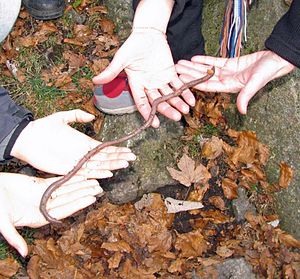Baden giant earthworm
| Baden giant earthworm | ||||||||||||
|---|---|---|---|---|---|---|---|---|---|---|---|---|

Baden giant earthworm ( Lumbricus badensis ) |
||||||||||||
| Systematics | ||||||||||||
|
||||||||||||
| Scientific name | ||||||||||||
| Lumbricus badensis | ||||||||||||
| Michaelsen , 1907 |
The Baden giant earthworm ( Lumbricus badensis ) is a ringworm from the earthworm family . The species is endemic to the spruce forests of the Feldberg area and the largest Lumbricus species in Europe.
features
The Baden giant earthworm has a length of 30 to 34 cm when resting and up to 60 cm when stretched out. The animals are 12 to 16 mm in diameter and weigh 24 to 32 g, occasionally up to 40 g. The number of body segments is 190 to 210. As with all Lumbrici , the head shape is tanylob , which means that the head flap divides the first back segment. The clitellum is saddle-shaped and comprises segments 31 to 38 or 32 to 38; an extension to segment 40 occasionally occurs. The front third of the body is dark purple to dark red-brown, the two rear thirds are lead-gray to light gray.
distribution
The species was scientifically described for the first time in 1906 and lives in a small area in the southern Black Forest , at altitudes between 300 and 1400 m above sea level. The common earthworm ( Lumbricus terrestris ) and related species are absent in the relatively acidic soils on primary rock of the spruce forests , so that the species L. badensis was able to spread there.
Evolutionary origin
Biogeographical studies have shown that the last common ancestor of the Baden giant earthworm and its smaller sister species Lumbricus friendi lived less than 10,000 years ago at the end of the last Ice Age. Geographical isolation over the Rhine , presumably through the drifting of large earth-root balls, created Lumbricus - founder populations that were able to colonize the earthworm-free acidic soils in the southern Black Forest. In the course of just a few thousand years, the today geographically and reproductively isolated organic species Lumbricus badensis and Lumbricus friendi emerged from a precursor species (archaic L. friendi ) ( allopatric speciation ). The question of how the Baden giant earthworm was able to evolve to such a size in such a short time has not been answered without a doubt. Larger individuals may benefit from several selection advantages: an improved body's own fluid accumulation during dry periods, a wider radius of action for above-ground food procurement and the ability to procure larger leaves and pieces of sticks, as well as the ability to create deeper retraction tubes.
Way of life
The Baden giant earthworm can live to be up to 20 years old, remains true to its up to 2.5 m deep living tube and provides brood care by creating underground chambers . By creating such deep tubes, the earthworms can survive even severe winters without death from frost. The living tubes are up to 15 mm wide and papered with humus excrement from earthworms. The segmented worms decompose the spruce needles with the participation of microorganisms. The endemic annelid worms are therefore important for the degradation of litter in the soils of the southern Black Forest.
Appreciation
The uniqueness of its occurrence increasingly attracts ecotourists to the region, so that a children's park was created in its honor, in which visitors can follow an "earthworm trail" and the worm is honored in the form of a child-friendly, oversized work of art.
literature
- Ulrich Kutschera , J. Malcolm Elliott (2010): Charles Darwin's observations on the behavior of earthworms and the evolutionary history of a giant endemic species from Germany, Lumbricus badensis (Oligochaeta: Lumbricidae). In: Applied and Environmental Soil Science 2.1-11. (PDF; 2.2 MB) ( HTML )
- Franz Lamparski (1985): The influence of the earthworm species Lumbricus badensis on forest soils in the southern Black Forest. Freiburger Bodenenkundliche Abhandlungen, H. 15; Institute f. Soil science u. Forest Nutrition d. Albert Ludwig University, Freiburg im Breisgau ( summary ); zugl. Diss. under d. Title: The earthworm Lumbricus badensis - its living tube, its distribution and its influence on the soils in the southern Black Forest.
- Kai Brigandt (2001): The Baden earthworm Lumbricus badensis under laboratory conditions in biology lessons. Knowledge Hausarb., Secondary school biology, pedagogue. Freiburg University of Applied Sciences ( biblical proof) .
Web links
- Senckenberg Society for Nature Research: Underground Population Census , press release 2014.
Individual evidence
- ↑ Earthworm workshop: head rags. On: uni-muenster.de , accessed on June 24, 2016
- ↑ Kai Brigandt (2001): The Baden earthworm Lumbricus badensis under laboratory conditions in biology lessons . Knowledge Hausarb., Secondary school biology, pedagogue. Freiburg University of Applied Sciences (electronic resource, 137 p., Ill., PDF): p. 28
- ↑ a b Kutschera and Elliott, p. 7
- ↑ Brigandt, Kai, p. 24
- ↑ a b Lamparski, Franz, pp. 49 and 51
- ↑ The Belchen Adventure Trail "Earthworm Path" Excursion Destinations - Details - Black Forest Region Belchen. Retrieved July 4, 2020 .